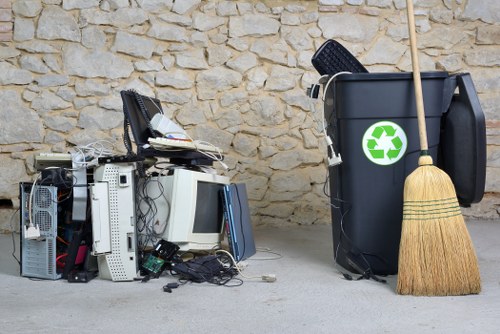Waste Removal in Mega Waste: Efficient Solutions for Large-Scale Challenges
Understanding Mega Waste

Mega waste refers to the extensive accumulation of waste generated by large urban centers, industries, and expansive population growth. Managing this colossal amount of waste poses significant challenges, necessitating innovative and efficient waste removal strategies.
The volume and complexity of mega waste require specialized approaches that go beyond traditional waste management practices. Effective waste removal in such contexts not only ensures cleanliness but also promotes environmental sustainability and public health.
As cities expand and industrial activities increase, the generation of mega waste continues to rise. Addressing this issue involves a multifaceted strategy encompassing collection, transportation, treatment, and disposal of waste materials.
Challenges in Mega Waste Management

Managing mega waste is fraught with numerous challenges, including:
- High volume and diverse types of waste
- Limited space for waste disposal sites
- Environmental regulations and compliance
- Financial constraints in implementing advanced technologies
- Public awareness and participation
These challenges necessitate the adoption of scalable and sustainable waste removal solutions that can handle the demands of large-scale waste generation.
Furthermore, the rapid urbanization in many parts of the world exacerbates the problem, making it imperative for waste management systems to evolve accordingly.
Innovative Waste Removal Techniques

To efficiently manage mega waste, various innovative waste removal techniques have been developed. These include:
- Automated Waste Collection Systems: Utilizing technology to streamline waste collection processes.
- Recycling and Reuse Programs: Promoting the segregation and recycling of waste materials.
- Waste-to-Energy (WTE) Plants: Converting waste into usable energy.
- Sanitary Landfills: Engineered sites designed to minimize environmental impact.
- Composting: Transforming organic waste into compost for agricultural use.
These techniques not only enhance the efficiency of waste removal but also contribute to environmental conservation by reducing landfill dependency and promoting resource recovery.
Integrating these methods into a cohesive waste management strategy is essential for addressing the complexities of mega waste.
Technological Advancements in Waste Removal

Technological advancements play a pivotal role in revolutionizing waste removal in mega waste scenarios. Key technologies include:
- Smart Bins: Equipped with sensors to monitor waste levels and optimize collection routes.
- Automated Sorting Systems: Enhancing the efficiency of waste separation and recycling processes.
- Advanced Recycling Technologies: Facilitating the processing of complex waste materials.
- GIS Mapping: Assisting in the planning and management of waste collection services.
- Biotechnological Solutions: Utilizing microorganisms to break down waste materials.
These technologies not only improve the effectiveness of waste removal operations but also contribute to reducing operational costs and environmental impact.
Embracing these innovations is crucial for cities and industries aiming to manage mega waste sustainably.
Environmental Impact of Mega Waste

Mega waste has significant environmental implications, including:
- Pollution of air, soil, and water resources
- Greenhouse gas emissions contributing to climate change
- Loss of biodiversity due to habitat disruption
- Health hazards arising from improper waste disposal
- Resource depletion as recyclable materials are wasted
Addressing the environmental impact of mega waste requires comprehensive waste removal strategies that prioritize sustainability and minimize ecological footprints.
Implementing effective waste management practices not only mitigates environmental degradation but also fosters a healthier and more sustainable living environment for communities.
Strategies for Effective Waste Removal
Effective waste removal in mega waste contexts involves a combination of strategies, such as:
- Integrated Waste Management: Combining various waste treatment and disposal methods for optimal results.
- Public-Private Partnerships: Collaborating with private entities to enhance waste management infrastructure.
- Regulatory Frameworks: Establishing policies and standards to govern waste removal practices.
- Community Engagement: Encouraging public participation in waste segregation and recycling initiatives.
- Investment in Infrastructure: Developing facilities and technologies necessary for efficient waste management.
By implementing these strategies, municipalities and organizations can enhance their waste removal capabilities, ensuring effective management of mega waste.
Continuous assessment and adaptation of these strategies are essential to keep pace with the evolving waste generation patterns.
Case Studies: Successful Mega Waste Removal
Several cities and regions have demonstrated successful mega waste removal through innovative approaches:
- Singapore: Implemented an extensive waste-to-energy program, significantly reducing landfill dependence.
- Tokyo: Utilizes advanced automated waste collection systems to manage high population density waste efficiently.
- San Francisco: Achieved high recycling rates through comprehensive public engagement and robust recycling programs.
- Copenhagen: Focuses on sustainable waste management practices, including anaerobic digestion and composting.
These case studies provide valuable insights into the effective waste removal techniques and strategies that can be replicated in other mega waste scenarios.
Learning from these examples can guide cities and organizations in developing tailored waste management solutions.
Future Trends in Waste Removal
The future of waste removal in mega waste contexts is poised to be shaped by several emerging trends:
- Circular Economy: Emphasizing the reuse and recycling of materials to minimize waste generation.
- Artificial Intelligence (AI): Enhancing waste sorting and management through intelligent systems.
- Blockchain Technology: Improving transparency and traceability in waste management processes.
- Decentralized Waste Management: Implementing localized waste treatment facilities to reduce transportation needs.
- Sustainable Packaging: Reducing waste at the source through eco-friendly packaging solutions.
These trends reflect a shift towards more sustainable and efficient waste management practices, addressing the growing concerns associated with mega waste.
Adopting these trends can help mitigate the environmental and societal impacts of large-scale waste generation.
Implementing Waste Removal Solutions
Successful implementation of waste removal solutions in mega waste scenarios involves several key steps:
- Assessment and Planning: Evaluating current waste generation and management practices to identify areas for improvement.
- Stakeholder Engagement: Involving all relevant parties, including government, businesses, and the community, in the planning process.
- Technology Integration: Adopting advanced technologies to enhance waste collection, sorting, and treatment.
- Policy Development: Establishing regulations and incentives to support sustainable waste management practices.
- Monitoring and Evaluation: Continuously tracking the effectiveness of waste removal strategies and making necessary adjustments.
These steps ensure a structured and effective approach to managing mega waste, leading to sustainable and scalable waste removal solutions.
Continuous improvement and adaptability are essential components of successful waste management implementation.
Role of Communities in Waste Removal
Communities play a vital role in the success of waste removal initiatives. Their involvement can significantly enhance the effectiveness of waste management strategies through:
- Waste Segregation: Proper separation of recyclable and non-recyclable materials at the source.
- Recycling Participation: Active engagement in recycling programs to reduce overall waste.
- Environmental Awareness: Promoting education and awareness about the importance of waste management.
- Volunteer Initiatives: Participating in community clean-up events and other waste management activities.
- Feedback and Advocacy: Providing input and advocating for better waste management policies and practices.
Empowering communities fosters a collaborative environment where waste removal efforts are more effective and sustainable.
Community-driven initiatives complement institutional waste management efforts, leading to comprehensive and inclusive waste removal solutions.
Economic Benefits of Efficient Waste Removal
Efficient waste removal in mega waste scenarios offers numerous economic benefits, including:
- Job Creation: Developing waste management infrastructure and services creates employment opportunities.
- Cost Savings: Reducing waste through recycling and reuse minimizes disposal costs.
- Resource Recovery: Extracting valuable materials from waste can generate revenue streams.
- Infrastructure Development: Investing in waste management infrastructure stimulates economic growth.
- Health Cost Reduction: Minimizing waste-related health issues reduces healthcare expenses.
These economic advantages underscore the importance of prioritizing efficient waste removal in large-scale waste management strategies.
Implementing effective waste management practices can lead to sustainable economic development and improved quality of life.
Policy Recommendations for Mega Waste Removal
To enhance waste removal in mega waste contexts, the following policy recommendations are essential:
- Strengthening Environmental Regulations: Enforcing strict regulations to govern waste disposal and management practices.
- Incentivizing Recycling and Reuse: Providing incentives for businesses and individuals to engage in recycling and reuse activities.
- Promoting Public-Private Partnerships: Encouraging collaboration between the public sector and private enterprises in waste management.
- Investing in Research and Development: Supporting the development of innovative waste management technologies and solutions.
- Enhancing Infrastructure: Building and upgrading waste management facilities to handle large volumes of waste efficiently.
These policy measures can create a conducive environment for effective waste removal and sustainable waste management in mega waste scenarios.
Comprehensive policy frameworks are crucial for guiding and supporting waste management initiatives.
Conclusion: Moving Towards Sustainable Waste Management
Waste removal in mega waste contexts is a formidable challenge that requires a comprehensive and strategic approach. By understanding the complexities of mega waste, adopting innovative waste removal techniques, leveraging technological advancements, and fostering community involvement, it is possible to manage large-scale waste effectively.
Implementing sustainable waste management practices not only addresses environmental and health concerns but also contributes to economic growth and societal well-being. Embracing future trends and continuous improvement ensures that waste removal systems remain efficient and adaptable to evolving needs.
Contact us today to learn more about how we can help you implement effective waste removal solutions and contribute to a cleaner, more sustainable future.